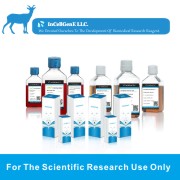

Overview
| Organism | Homo sapiens, human |
|---|---|
| Tissue | cervix; derived from metastatic site: lymph node |
| Product Format | frozen |
| Morphology | epithelial |
| Culture Properties | adherent |
| Biosafety Level |
2 [Cells contain human papilloma virus]
Biosafety classification is based on U.S. Public Health Service Guidelines, it is the responsibility of the customer to ensure that their facilities comply with biosafety regulations for their own country. |
| Disease | epidermoid carcinoma |
| Age | 47 years |
| Gender | female |
| Ethnicity | Caucasian |
| Storage Conditions | liquid nitrogen vapor phase |
Properties
| Karyotype |
model number = 39; range = 38 to 41. This is a hypodiploid human cell line with the modal chromosome number of 39, occurring in 62% of cells. The rate of cells with higher ploidies was 16%. Sixteen markers were found in single copies in all cells. They include del(2) (q34), del(8) (p21), 14p+, der(X)t(X;14) (q28;q13), t(3q8q) and eleven others. A few different markers, all of which had 11qter--11p13 [der(11)] in common, were found. These markers appeared to be mutually exclusive, each cell having one, and only one, marker at a time. Normal X, N8, N11, N21 and N22 were absent. N1, N10, N15, and N16 were paired, and other normal chromosomes were single. |
|---|---|
| Derivation | This line was derived by J. Sykes (see also ATCC HTB-33) in 1974. |
| Clinical Data |
female
Caucasian
47 years
|
| Antigen Expression |
Blood Type AB; Rh+
|
| Tumorigenic | Yes, in nude mice; forms poorly differentiated epidermoid carcinoma (grade III). |
| Comments |
MS751 cells have been reported to contain human papilloma virus 18 (HPV-18) sequences. More recently, it has been shown that MS751 cells contain a partial HPV-45 genome, and that HPV-45 sequences from the E6/E7 region are expressed as poly(A)+ RNA.
|
Background
| Complete Growth Medium |
The base medium for this cell line is ATCC-formulated Eagle''s Minimum Essential Medium, Catalog No. 30-2003. To make the complete growth medium, add the following components to the base medium: fetal bovine serum to a final concentration of 10%. |
|---|---|
| Subculturing |
Volumes used in this protocol are for 75 cm2 flask; proportionally reduce or increase amount of dissociation medium for culture vessels of other sizes.
Subcultivation Ratio: 1:2 to 1:5 Note: For more information on enzymatic dissociation and subculturing of cell lines consult Chapter 10 in Culture of Animal Cells, a Manual of Basic Technique by R. Ian Freshney, 3rd edition, published by Alan R. Liss, N.Y., 1994. |
| Cryopreservation |
Complete growth medium, 95%; DMSO, 5%. Cell culture tested DMSO is available as ATCC Catalog No. 4-X.
|
| Culture Conditions |
Temperature: 37��C
Atmosphere: Air, 95%; Carbon dioxide (CO2), 5%
|


